原因状语从句的用法
原因状语从句(完整)

原因状语从句(完整)
原因状语从句是一种从句,用来表示某种事件或情况的原因。
它通常由“因为”、“既然”、“由于”、“如果”等引导词开头,以下是一些常用的原因状语从句及其用法:
1.因为(because)
用法:因为引导的原因状语从句可以放在句首或句中,用来解释主句中的原因。
例句:因为他昨晚没睡好,今天一整天都很疲倦。
2.既然(since)
用法:既然引导的原因状语从句表示相信某个前提条件,因此陈述主句中的结果或结论。
例句:既然你已经完成了这项工作,我们就可以开始进行下一步了。
3.由于(due to)
例句:由于天气不好,我们无法进行户外活动。
4.如果(if)
例句:如果你需要帮助,尽管告诉我,我很乐意为你效劳。
5.只要(as long as)
例句:只要你好好学习,你就会成功。
6.尽管(even though)
例句:尽管天气不好,但我们仍然决定继续我们的计划。
7.虽然(although)
用法:虽然引导的原因状语从句表示一个与主句相反的情况,用来表达抱怨、惊讶等情绪。
例句:虽然我跟他说了很多遍,但他还是不肯听我的建议。
8.随着(as/with)
例句:随着科技的进步,我们的生活变得越来越便利。
总之,原因状语从句是一种非常重要的语法结构,它可以表达出各种事件或情况的原因,让句子的意思更加清晰明了。
希望通过以上的例句和用法介绍,能够帮助大家更好地掌握原因状语从句的用法。
原因状语从句

原因状语从句Company number:【WTUT-WT88Y-W8BBGB-BWYTT-19998】二、原因状语从句:1、定义:在句中用来说明主句原因的句子叫原因状语从句。
2、常用引导词: because(因为), as (由于), since (既然), now (that) (既然)3、时态:原因状语从句一般都是根据实际情况选用适当的时态。
通常是主过从过,主现从现。
4、because, since和as的区别:1) because引导的原因状语一般放于主句的后面,because从句位于句首时要用逗号分开,放在句末时,可不用逗号分开。
because表示直接原因,语气最强,最适合回答why引导的。
because of 也表示原因,但它后面不接从句, 只能接名词, 代词或动名词。
注意:because 和so 不可同时出现在一个句子里。
①I do it because I like it. = I like it so I do it.②We went by bus because it was cheaper. = It was cheaper so we went by bus.③ He can’t go to school because of his illness.2) since引导的原因状语一般放于主句之前表示已知的、显然的理由(通常被翻译成“既然”= now that ),较为正式,语气比because弱。
①Since you are free today, you had better help me with my mathematics.②Since you don't trust him, you should not employ him.③Now (that) you are grown up, you should not rely on your parents.3) as引导原因状语时表示附带说明的“双方已知的原因”,含有对比说明的意味,语气比since弱,较为正式,位置较为灵活(常放于主句之前)。
原因状语从句的用法
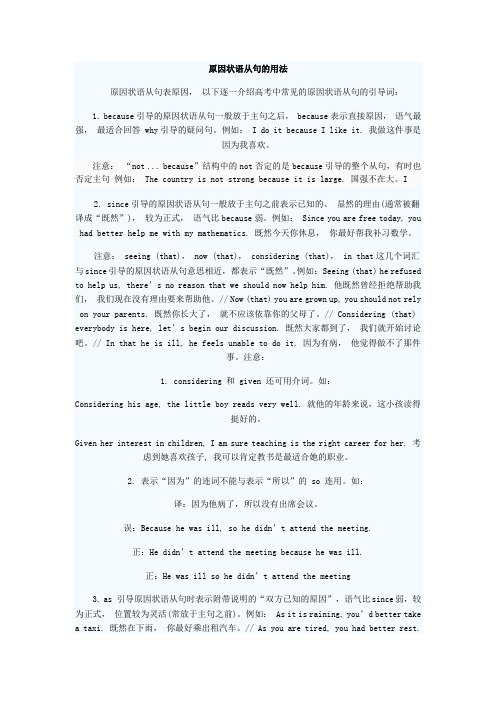
原因状语从句的用法原因状语从句表原因,以下逐一介绍高考中常见的原因状语从句的引导词:1. because引导的原因状语从句一般放于主句之后, because表示直接原因,语气最强,最适合回答 why引导的疑问句。
例如: I do it because I like it. 我做这件事是因为我喜欢。
注意:“not ... because”结构中的not否定的是because引导的整个从句,有时也否定主句例如: The country is not strong because it is large. 国强不在大。
I2. since引导的原因状语从句一般放于主句之前表示已知的、显然的理由(通常被翻译成“既然”),较为正式,语气比because弱。
例如: Since you are free today, you had better help me with my mathematics. 既然今天你休息,你最好帮我补习数学。
注意: seeing (that), now (that), considering (that), in that这几个词汇与since引导的原因状语从句意思相近,都表示“既然”。
例如: Seeing (that) he refused to help us, there’s no reason that we should now help him. 他既然曾经拒绝帮助我们,我们现在没有理由要来帮助他。
// Now (that) you are grown up, you should not rely on your parents. 既然你长大了,就不应该依靠你的父母了。
// Considering (that) everyb ody is here, let’s begin our discussion. 既然大家都到了,我们就开始讨论吧。
// In that he is ill, he feels unable to do it. 因为有病,他觉得做不了那件事。
初中英语知识点归纳原因状语从句的用法

初中英语知识点归纳原因状语从句的用法原因状语从句是英语中的一个重要语法结构,用于表达某个事件或行为的原因。
它由一个主句和一个从句构成,从句中包含一个引导词和一个完整的句子。
在本文中,我们将对初中英语中的原因状语从句的用法进行归纳总结。
1. 引导词:because、as、since这三个词都可以用来引导原因状语从句,表示某个事件或行为的原因。
例如:- I couldn't sleep last night because it was too noisy outside.- As I was tired, I went to bed early.- Since he was busy, he couldn't come to the party.2. 引导词:because of、due to、as a result of这些短语也可以用来引导原因状语从句,表示某个事件或行为的原因,但需要和名词或名词性短语连用。
例如:- We couldn't go to the park because of the heavy rain.- I was absent from school due to illness.- He couldn't attend the meeting as a result of a traffic jam.3. 引导词:since、as、now that这些词可以用来引导原因状语从句,表示某个事件或行为的原因,并且暗示着原因是已知的或对方已经了解。
例如:- Since you are not feeling well, you should stay home and rest.- As it is getting late, we should leave now.- Now that you have finished your homework, you can watch TV.4. 引导词:in order that、so that这些词可以用来引导原因状语从句,表达某个事件或行为的目的。
状语从句的种类与用法详解

状语从句的种类与用法详解状语从句是英语语法中的重要部分,它在句子中充当状语,用于修饰、限定主句的动作、状态或其他方面。
状语从句有多种种类和用法,下面将对其进行详细解析。
1. 时间状语从句时间状语从句用于表示主句中的动作发生的时间,具体用法如下:- 当主句谓语动词表示延续性动作时,使用while引导的时间状语从句。
例如:While I was studying for the exam, my phone rang.(当我正在备考时,我的手机响了。
)- 当主句谓语动词表示瞬时性动作时,使用when或as引导的时间状语从句。
例如:When I arrived at the station, the train had already left.(当我到达车站时,火车已经开走了。
)2. 地点状语从句地点状语从句用于表示主句中的动作发生的地点,具体用法如下:- 使用where引导的地点状语从句。
例如:I will meet her where we had our first date.(我会在我们第一次约会的地方见她。
)3. 原因状语从句原因状语从句用于表示主句中的动作发生的原因,具体用法如下:- 使用because或since引导的原因状语从句。
例如:He couldn't come to the party because he had to work overtime.(他不能来参加聚会,因为他得加班。
)- 使用as引导的原因状语从句,强调两个动作同时发生。
例如:As the sun set, the sky turned orange.(太阳下山时,天空变成橙色。
)4. 条件状语从句条件状语从句用于表示主句中的动作发生的条件,具体用法如下:- 使用if或unless引导的条件状语从句。
例如:If it rains tomorrow, we will stay indoors.(如果明天下雨,我们将呆在室内。
原因状语从句的用法
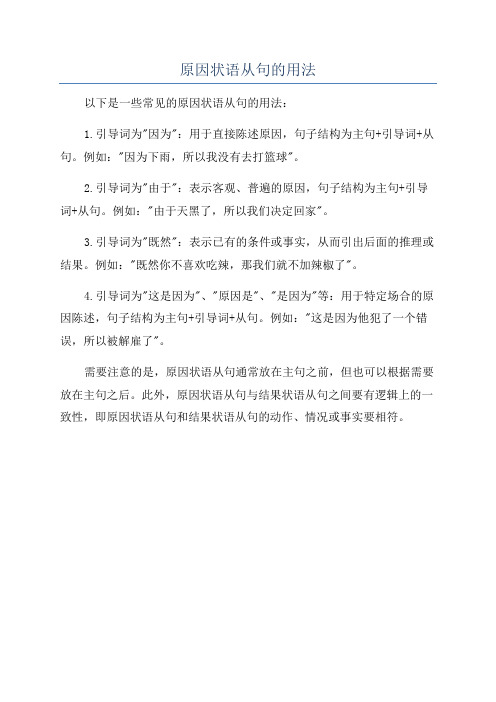
原因状语从句的用法
以下是一些常见的原因状语从句的用法:
1.引导词为"因为":用于直接陈述原因,句子结构为主句+引导词+从句。
例如:"因为下雨,所以我没有去打篮球"。
2.引导词为"由于":表示客观、普遍的原因,句子结构为主句+引导词+从句。
例如:"由于天黑了,所以我们决定回家"。
3.引导词为"既然":表示已有的条件或事实,从而引出后面的推理或结果。
例如:"既然你不喜欢吃辣,那我们就不加辣椒了"。
4.引导词为"这是因为"、"原因是"、"是因为"等:用于特定场合的原因陈述,句子结构为主句+引导词+从句。
例如:"这是因为他犯了一个错误,所以被解雇了"。
需要注意的是,原因状语从句通常放在主句之前,但也可以根据需要放在主句之后。
此外,原因状语从句与结果状语从句之间要有逻辑上的一致性,即原因状语从句和结果状语从句的动作、情况或事实要相符。
原因状语从句语法讲解

原因状语从句语法讲解以下是原因状语从句的语法讲解:1.引导词:原因状语从句通常由以下引导词引导:- because(因为)- since(因为,自从)- as(因为,既然)- as a result of(由于)- due to(由于)- owing to(由于)- now that(既然)2.引导词用法:- because和since通常表示明显的原因,语义上较强,可以置于句首或句尾。
例如:He is crying because he lost his toy.(他哭了,因为他丢了他的玩具。
)- as表示理由,常不置于句首,一般位于句中或句尾。
例如:Helikes soccer as he enjoys playing with his friends.(他喜欢足球,因为他喜欢和朋友一起玩。
)- as a result of、due to、owing to表示结果或原因,一般置于句首。
例如:As a result of the rain, the game was canceled.(由于下雨,比赛被取消了。
)- now that表示既然,常置于句首。
例如:Now that you have finished your homework, you can go out and play.(既然你已经做完作业了,你可以出去玩了。
)3.句子结构:- 原因状语从句通常由主语、谓语和宾语等组成,可以包含其他从句。
例如:He is sad because he failed the test yesterday.(他因为昨天考试没及格而感到难过。
)- 状语从句的主谓结构与主句的一致。
例如:I can't go to the park because it is raining.(因为正在下雨,所以我不能去公园。
)。
原因状语从句
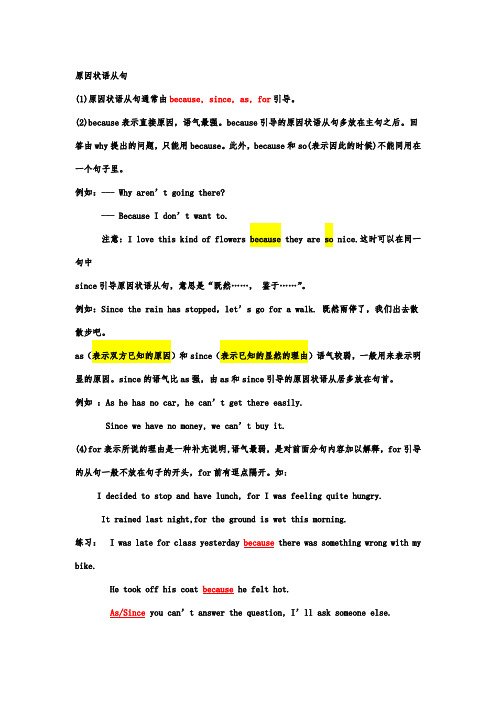
原因状语从句(1)原因状语从句通常由because, since, as, for引导。
(2)because表示直接原因,语气最强。
because引导的原因状语从句多放在主句之后。
回答由why提出的问题,只能用because。
此外,because和so(表示因此的时候)不能同用在一个句子里。
例如:--- Why aren’t going there?--- Because I don’t want to.注意:I love this kind of flowers because they are so nice.这时可以在同一句中since引导原因状语从句,意思是“既然……,鉴于……”。
例如:Since the rain has stopped,let’s go for a walk. 既然雨停了,我们出去散散步吧。
as(表示双方已知的原因)和since(表示已知的显然的理由)语气较弱,一般用来表示明显的原因。
since的语气比as强,由as和since引导的原因状语从居多放在句首。
例如:As he has no car, he can’t get there easily.Since we have no money, we can’t buy it.(4)for表示所说的理由是一种补充说明,语气最弱,是对前面分句内容加以解释,for引导的从句一般不放在句子的开头,for前有逗点隔开。
如:I decided to stop and have lunch, for I was feeling quite hungry.It rained last night,for the ground is wet this morning.练习:I was late for class yesterday because there was something wrong with my bike.He took off his coat because he felt hot.As/Since you can’t answer the question, I’ll ask someone else.The day breaks,for the bird sings.二、结果状语从句(1)结果状语从句由so…that, such…that, so that引导。
原因状语从句用法总结
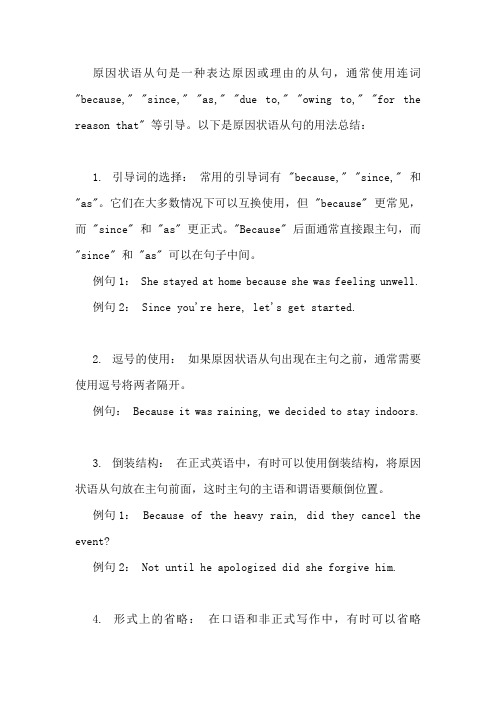
原因状语从句是一种表达原因或理由的从句,通常使用连词 "because," "since," "as," "due to," "owing to," "for the reason that" 等引导。
以下是原因状语从句的用法总结:1. 引导词的选择: 常用的引导词有 "because," "since," 和 "as"。
它们在大多数情况下可以互换使用,但 "because" 更常见,而 "since" 和 "as" 更正式。
"Because" 后面通常直接跟主句,而 "since" 和 "as" 可以在句子中间。
例句1: She stayed at home because she was feeling unwell.例句2: Since you're here, let's get started.2. 逗号的使用: 如果原因状语从句出现在主句之前,通常需要使用逗号将两者隔开。
例句: Because it was raining, we decided to stay indoors.3. 倒装结构: 在正式英语中,有时可以使用倒装结构,将原因状语从句放在主句前面,这时主句的主语和谓语要颠倒位置。
例句1: Because of the heavy rain, did they cancel the event?例句2: Not until he apologized did she forgive him.4. 形式上的省略: 在口语和非正式写作中,有时可以省略"that" 或 "because",使句子更简洁。
英语原因状语从句

英语原因状语从句
英语中的原因状语从句用来表示件事情发生的原因或理由。
在原因状
语从句中,常常使用以下引导词:
1. because: 因为
2. since: 因为
3. as: 由于;因为
4. given that: 鉴于;由于
5. seeing that: 鉴于;由于
6. considering (that): 考虑到;鉴于
7. due to: 由于;因为
8. owing to: 由于;因为
例如:
- Since it's raining outside, we should bring umbrellas. (由
于外面在下雨,我们应该带雨伞。
- As he had already left, I couldn't give him the message. (由于他已经离开了,所以我不能给他传达消息。
)
- Given that it's late, we should go home now. (鉴于已经很晚,我们现在应该回家了。
)
- Considering the price, this car is a good deal. (考虑到这
个价格,这辆车是个不错的交易。
)
- Due to bad weather, the flight was cancelled. (由于恶劣的
天气,航班被取消了。
)
- Owing to his hard work, he was promoted. (由于他的努力工作,他得到了晋升。
常用句型之十七原因状语从句

常用句型之十七原因状语从句原因状语从句是英语中常用的一种从句类型,可以对一个事件或情况进行解释,说明其背后的原因。
本文将介绍常见的原因状语从句句型,并通过例句来展示其用法。
原因状语从句通常由连词“because”、“since”、“as”、“due to”、“owing to”、“on account of”等引导。
句型一:(主句)+ because + (从句)例句:She couldn't come to the party because she was sick.她不能参加派对,因为她生病了。
He failed the exam because he didn't study enough.他考试不及格是因为他没有好好学习。
句型二:(主句) + since + (从句)例句:I have been feeling tired since I started my new job.自从我开始新工作以来,我一直感到疲倦。
He has been acting strangely since he broke up with his girlfriend.自从他和女朋友分手以来,他一直行为奇怪。
句型三:(主句) + as + (从句)例句:As it was getting late, we decided to leave.因为天色已晚,我们决定离开。
He couldn't find his keys as he had left them in the car.他找不到钥匙,因为他把它们落在了车里。
句型四:(主句) + due to + (从句)例句:The flight was delayed due to bad weather conditions.航班因天气恶劣而延误。
He was unable to attend the meeting due to a family emergency.因为家庭紧急情况,他无法参加会议。
原因状语从句的用法

原因状语从句的用法以下是一些常见的用法:1. "because"引导的原因状语从句:- I didn't go to the party because I was tired.(我没去参加聚会,因为我累了。
)- She didn't finish her homework because she forgot herbooks at school.(她没完成作业,因为她把书忘在学校了。
)2. "since"引导的原因状语从句(可以用来表示原因或时间):- Since it's raining, we can't go to the park.(因为下雨了,我们不能去公园。
)3. "as"引导的原因状语从句(可以用来表示原因或方式):- As it was getting late, we decided to leave.(由于时间已晚,我们决定离开。
)- As she spoke softly, I had to lean in to hear her.(她说话声音很低,我得凑过去听她说什么。
4. "as a result of"引导的原因状语从句(通常用于正式场合):- As a result of heavy traffic, I arrived late for the meeting.(由于交通拥堵的结果,我迟到了会议。
)需要注意的是,原因状语从句通常放在主句之前,但也可以放在主句之后,这时从句前面要加逗号:- I didn't attend the meeting, because I had a doctor's appointment.(我没有参加会议,因为我有个医生预约。
)- We had to cancel the picnic since it was raining heavily.(由于下大雨,我们不得不取消野餐计划。
原因状语从句的用法
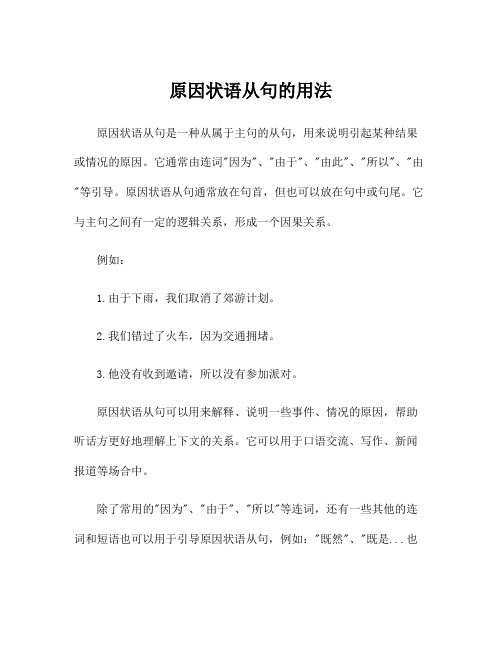
原因状语从句的用法
原因状语从句是一种从属于主句的从句,用来说明引起某种结果或情况的原因。
它通常由连词"因为"、"由于"、"由此"、"所以"、"由"等引导。
原因状语从句通常放在句首,但也可以放在句中或句尾。
它与主句之间有一定的逻辑关系,形成一个因果关系。
例如:
1.由于下雨,我们取消了郊游计划。
2.我们错过了火车,因为交通拥堵。
3.他没有收到邀请,所以没有参加派对。
原因状语从句可以用来解释、说明一些事件、情况的原因,帮助听话方更好地理解上下文的关系。
它可以用于口语交流、写作、新闻报道等场合中。
除了常用的"因为"、"由于"、"所以"等连词,还有一些其他的连词和短语也可以用于引导原因状语从句,例如:"既然"、"既是...也
是..."、"出于"、"由此可见"等。
这些连词和短语在句子中的位置和语态可能有所变化,但作用都是引导原因状语从句。
要特别注意的是,原因状语从句使用的时态应根据主句的时态和语境来确定。
如果主句是过去时,则原因状语从句多使用过去时。
如果主句是现在时,则原因状语从句可以使用现在时,过去时或可能将来时,视具体情况而定。
总的来说,原因状语从句的用法很灵活,可以在句子中起到连接主句与状语从句的作用,并帮助读者或听众更好地理解句子的含义和逻辑关系。
because引导原因状语从句
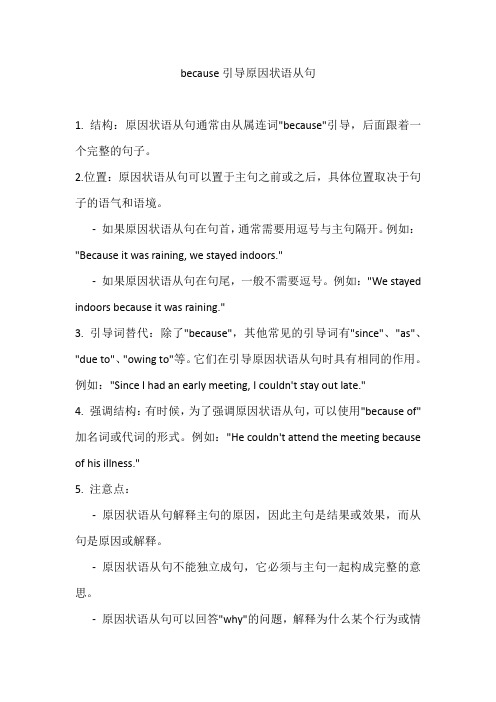
because引导原因状语从句1. 结构:原因状语从句通常由从属连词"because"引导,后面跟着一个完整的句子。
2.位置:原因状语从句可以置于主句之前或之后,具体位置取决于句子的语气和语境。
-如果原因状语从句在句首,通常需要用逗号与主句隔开。
例如:"Because it was raining, we stayed indoors."-如果原因状语从句在句尾,一般不需要逗号。
例如:"We stayed indoors because it was raining."3. 引导词替代:除了"because",其他常见的引导词有"since"、"as"、"due to"、"owing to"等。
它们在引导原因状语从句时具有相同的作用。
例如:"Since I had an early meeting, I couldn't stay out late."4. 强调结构:有时候,为了强调原因状语从句,可以使用"because of"加名词或代词的形式。
例如:"He couldn't attend the meeting because of his illness."5. 注意点:-原因状语从句解释主句的原因,因此主句是结果或效果,而从句是原因或解释。
-原因状语从句不能独立成句,它必须与主句一起构成完整的意思。
-原因状语从句可以回答"why"的问题,解释为什么某个行为或情况发生。
下面是一些例句,展示了"because"引导原因状语从句的用法:1、She didn't go to the party because she had to study for her exam.她没去参加聚会,因为她得准备考试。
原因状语从句

原因状语从句就是在复合句中表示 主句动作发生原因的状语从句。用 于引导原因状语从句最常用的连词 是because,另外还有as, since以及now that等 。 1. 用because引导:because是引导原因状语从 句最常用的连词,其意为“因为”。如: The little boy was crying because he was lost. 那小孩因迷路而哭。 I bought the house simply because it was large. 就是因为这所房子大我才买的。
பைடு நூலகம்
2. 用as引导:as也可以用于引导原因状语从句 ,意思是“由于”。如: As he is ill, he can’t come to the meeting. 由于 生病了,他不能来参加会议。 As you weren’t there, I left a message. 由于你不 在那儿,我留了个信儿。
练习
1.由于外面声音嘈杂我睡不着。 2.由于我们没钱,我们无法购买它。 3.你既然来了,最好还是留下吧(既来之,则 安之)。
2.Since [As] we’ve no money, we can’t buy it. 3.Now that you are here, you’d better stay.
5. 习惯用法:不要受汉语意思影响将表示“因 为”的连词与表示“所以”的 so 连用。如: 既然你很忙,那就不必来了。 正:As you are busy, you needn’t come. 正:You are busy, so you needn’t come. as是从属连词,在此引导原因状语从句; so 是并列连词,在此连接一个并列句,所 以误句结构混乱,应去掉其中一个。
原因状语从句

1、定义:在句中用来说明主句原因的句子叫原因状语从句。
2、常用引导词: because(因为), as (由于), since (既然), now (that) (既然)3、时态:原因状语从句一般都是根据实际情况选用适当的时态。
通常是主过从过,主现从现。
4、because, since和as的区别:1) because引导的原因状语从句一般放于主句的后面,because从句位于句首时要用逗号分开,放在句末时,可不用逗号分开。
because表示直接原因,语气最强,最适合回答why引导的疑问句。
because of 也表示原因,但它后面不接从句, 只能接名词, 代词或动名词。
注意:because 和so 不可同时出现在一个句子里。
①I do it because I like it. = I like it so I do it.②We went by bus because it was cheaper. = It was cheaper so we went by bus.③He can’t go to school because of his illness.2) since引导的原因状语从句一般放于主句之前表示已知的、显然的理由(通常被翻译成“既然”= now that ),较为正式,语气比because弱。
①Since you are free today, you had better help me with my mathematics.②Since you don't trust him, you should not employ him.③Now (that) you are grown up, you should not rely on your parents.3) as引导原因状语从句时表示附带说明的“双方已知的原因”,含有对比说明的意味,语气比since弱,较为正式,位置较为灵活(常放于主句之前)。
原因状语从句的引导词及句型

原因状语从句的引导词及句型原因状语从句是指用来表示某个动作或情况的原因的从句。
在句子中,原因状语从句通常作为原因状语的修饰语,用来解释主句中的动作或情况发生的原因。
在英语中,有一些特定的引导词和句型可以用来引导原因状语从句。
接下来,我们将介绍一些常见的原因状语从句引导词及句型。
1. 引导词"Because""Because"是最常用的原因状语从句引导词之一。
它通常用于正式和非正式的语境中,后接完整的句子。
例句:- She couldn't go to the party because she had to study for her exam.- We had to cancel the trip because it was raining heavily.2. 引导词"Since""Since"是用来引导原因状语从句的另一个常见引导词。
它的使用方式和"Because"相似,后接完整的句子。
例句:- He couldn't attend the meeting since he was feeling unwell.- Since she was late, she missed the beginning of the movie.3. 引导词"As"和"Seeing that""As"和"Seeing that"是两个比较正式的原因状语从句引导词,它们的使用方式和"Because"相似,后接完整的句子。
例句:- As it was getting late, we decided to leave.- Seeing that she was tired, I offered to help her carry the bags.4. 引导词"Now that"和"Given that""Now that"和"Given that"是用来引导原因状语从句的另两个常见引导词。
原因状语从句引导词用法归纳

【导语】以下是整理的《原因状语从句引导词⽤法归纳》,⼀起来看看吧!1、because的⽤法:because通常表⽰直接的原因。
because引导的从句表⽰直接⽽明确的原因和理由,表⽰按因果关系的推断,语⽓很强,⽤来回答why的问题,⼀般位于主句之后。
eg. We couldn't go out because these robber are still outside.2、for的⽤法:for是并列连词,引出的原因较间接,似乎是事后所想到的补充解释的理由,只陈述⼀般推断的理由,不⼀定表⽰产⽣结果的必然原因,主要放在两个并列句之间。
eg. It must be raining for lots of people running on the street.3、as和since的⽤法:表⽰已经知道的原因时⽤as或since,即某种原因在说话⼈看来已经很明显,或已为听话⼈所熟悉。
since要⽐as正式⼀些,它们通常被置于语句之前。
4、now that(既然)的⽤法:now that同since相似,语⽓较弱,强调⼈们已知的事实。
eg. Now that you are busy, you can give up this trip. 既然你很忙,你可以不去这个旅⾏。
5、because, since, as和for的⽐较① because语势,⽤来说明⼈所不知的原因,回答why提出的问题。
当原因是显⽽易见的或已为⼈们所知,就⽤as或 since。
②由because引导的从句如果放在句末,且前⾯有逗号,则可以⽤for来代替。
但如果不是说明直接原因,⽽是多种情况加以推断,就只能⽤for。
③⽤于强调句型时和被not所否定时都只能⽤because。
- 1、下载文档前请自行甄别文档内容的完整性,平台不提供额外的编辑、内容补充、找答案等附加服务。
- 2、"仅部分预览"的文档,不可在线预览部分如存在完整性等问题,可反馈申请退款(可完整预览的文档不适用该条件!)。
- 3、如文档侵犯您的权益,请联系客服反馈,我们会尽快为您处理(人工客服工作时间:9:00-18:30)。
原因状语从句的用法原因状语从句表原因,以下逐一介绍高考中常见的原因状语从句的引导词:1. because引导的原因状语从句一般放于主句之后, because表示直接原因,语气最强,最适合回答 why引导的疑问句。
例如: I do it because I like it. 我做这件事是因为我喜欢。
注意:“not ... because”结构中的not否定的是because引导的整个从句,有时也否定主句例如: The country is not strong because it is large. 国强不在大。
I2. since引导的原因状语从句一般放于主句之前表示已知的、显然的理由(通常被翻译成“既然”),较为正式,语气比because弱。
例如: Since you are free today, you had better help me with my mathematics. 既然今天你休息,你最好帮我补习数学。
注意: seeing (that), now (that), considering (that), in that这几个词汇与since引导的原因状语从句意思相近,都表示“既然”。
例如: Seeing (that) he refused to help us, there’s no reason that we should now help him. 他既然曾经拒绝帮助我们,我们现在没有理由要来帮助他。
// Now (that) you are grown up, you should not rely on your parents. 既然你长大了,就不应该依靠你的父母了。
// Considering (that) everyb ody is here, let’s begin our discussion. 既然大家都到了,我们就开始讨论吧。
// In that he is ill, he feels unable to do it. 因为有病,他觉得做不了那件事。
注意:1. considering 和 given 还可用介词。
如:Considering his age, the little boy reads very well. 就他的年龄来说,这小孩读得挺好的。
Given her interest in children, I am sure teaching is the right career for her. 考虑到她喜欢孩子, 我可以肯定教书是最适合她的职业。
2. 表示“因为”的连词不能与表示“所以”的 so 连用。
如:译:因为他病了,所以没有出席会议。
误:Because he was ill, so he didn’t attend the meeting.正:He didn’t attend the meeting because he was ill.正:He was ill so he didn’t attend the meeting3. as 引导原因状语从句时表示附带说明的“双方已知的原因”,语气比since弱,较为正式,位置较为灵活(常放于主句之前)。
例如:As it is raining, you’d better take a taxi. 既然在下雨,你最好乘出租汽车。
// As you are tired, you had better rest.既然累了,你最好休息一下。
// I went to bed early, as I was exhausted. 我睡得早,因为我筋疲力尽了。
4. for引导的原因状语从句并不说明主句行为发生的直接原因,只提供一些辅助性的补充说明, for引导的原因状语从句只能放于主句之后并且必须用逗号将其与主句隔开。
例如: He could not have seen me, for I was not there. 他不可能见过我,因为我不在那里。
[考题1]____ you’ve got a chance, you might as well make full use of it.A. Now thatB. AfterC. AlthoughD. As soon as [答案] A[解析]主句与从句之间存在因果关系,且“you’ve got a chance”表示一个显而易见的原因,因此应选用表原因的now that。
[考题2] He found it increasingly difficult to read, ____ his eyesight wasbeginning to fail. (2006北京)A. andB. forC. butD. or [答案] B[解析]“his eyesight was beginning to fail”是“he found it increasingly difficult to read”的原因,因此本题应选用可以表示原因的连词for引导原因状语从句。
时间状语从句的用法时间状语从句的引导词所表示的意思不尽相同,要注意把握不同的时间状语从句的引导词所表示的不同时间关系,以及它在具体句子中对应的对应时态、语态等问题。
1. when、 as、 while引导的时间状语从句分析:(1) when引导时间状语从句时表示“当……的时候”, when既可以指时间段也可指时间点,从句中既可用延续性动词又可用非延续性动词,且动作既可和主句的动作同时发生又可在主句的动作之前或之后发生,注意体会如下例句:I’ll call you when I get there. 我一到那里就给你打电话。
// When the wind blows, all the doors rattle. 只要风一吹,这门就吱嘎作响。
// He stopped trying, when he might have succeeded next time. 他不再试了,其实他可能下一次就成功。
// When I came home my wife was cooking dinner.我回家时,妻子在做晚饭。
如果when引导的时间状语从句的主语与主句主语相同,而从句的谓语又是be动词时,那么从句中的主语和be可以省略;当when引导的时间状语从句的主语与主句主语相同时,往往还可以用“when+分词”的形式替代该状语从句。
例如: When (you are) in trouble, ask her for help. 当你遭遇麻烦的时候去向她求助。
// When I came into the room(=When coming into the room), I found him lying there asleep. 当我进入房间的时候,我发现他躺在那儿睡着了。
(2) while引导时间状语从句时表示“当……的时候”,它强调主句的动作与从句的动作同时持续地进行,用于这一用法时while引导的时间状语从句和主句中的谓语动词必须是延续性动词,或者主句的动作发生在从句动作的进行过程中,主句中的谓语动词通常是非延续性动词,例如: Study while you study; play while you play. 该学习的时候就学习,该玩的时候就玩。
// I met her while I was at school. 当我在学校的时候我遇见了她。
(3) as引导时间状语从句时表示“当……时,一边……一边……”,侧重表示两个动作同时发生(包括一个主语同时进行两个动作),或者一种动作随着另一种动作的变化而变化。
例如: He jumps as he goes along. 他边走边跳。
// I slipped on the ice as I ran home. 我跑回家时在冰上滑了一跤。
// I saw him as he was getting off the bus. 正当他下公共汽车时, 我看见了他。
// As the wind rose the noise increased. 刮风的时候噪声增大。
[考题1] I had just steeped out of the bathroom and was busily drying myself with a towel ____ I heard the steps. (2006湖南)A. whileB. whenC. sinceD. after [答案] B[考题2] He was about halfway through his meal ____ a familiar voice cameto his ears. (2006辽宁)A. whyB. whereC. whenD. while [答案] C[考题3] We were swimming in the lake ____ suddenly the storm started.(2004北京春)A. whenB. whileC. untilD. before[答案] A[考题4]—I’m going to the post office.—____ you’re there, can you get me some stamps? (1999)A. AsB. WhileC. BecauseD. If[答案] B[解析]主句中“get me some stamps”的动作发生在时间状语从句“you’re there”的过程之中,因此应选while表示这一时间关系(属于while引导时间状语从句的两大基本用法之一)。
注意: as有时也可用于表示主句的动作发生在从句动作的过程中,但这一用法不是as引导时间状语从句的主要用法,表示主句的动作发生在从句动作的进行过程中时用while更为常见,因此B选项是最佳选项。
[考题5] ____ the days went on, the weather got worse. (1990)A. WithB. SinceC. WhileD. As [答案] D[解析]表示“the days went on”、“the weather got worse”两个相互伴随地进行变化的动作,应选as表示这一时间关系(while不适合用于这样的语境)。
[考题6] Tom ____ into the house when no one ____. (1992)A. slipped; was lookingB. had slipped; lookedC. slipped; had lookedD. was slipping; looked[答案] A[解析]题干当中的when表示“当……的时候”, slip表示“偷偷地、悄悄地移动”,在本题中表示非延续性的动作——“溜进了教室”的结果,不适合用进行时态表示。
